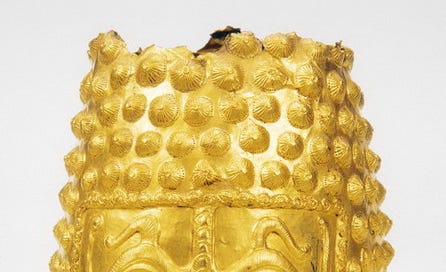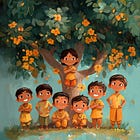Shekhar Kapur, Revolutionary Love, Gold Lost And Found - Monday Cup Of Links #90
Revolutionary acts of Sister Nivedita.
Happy Monday!
It was Republic Day yesterday. I tried to get my kid interested in the Republic Day Parade, but she didn’t care. Maybe it requires having nothing else exciting on TV ever to appreciate, I don’t know.
The Padma awards were announced. The names whose work I’m familiar with are economist, author and all-round great person, the late Bibek Debroy, actor Anant Nag, writer MT Vasudevan Nair, actress Shobhana, acting teacher Barry John, footballer IM Vijayan, actor Ajith, and filmmaker Shekhar Kapur.
It’s great to see Shekhar Kapur get the award, especially. Back in the day, he made the movie Elizabeth, starring Cate Blanchett as Elizabeth I. I remember the then Censor Board chief Asha Parekh making life hell for Shekhar Kapur, refusing to pass the movie without significant cuts. When I finally watched the movie, it seemed like yet another Hollywood movie, so I didn’t get the hype. But now I realize, that movie, as well as the sequel, Elizabeth: The Golden Age are a masterclass in historical storytelling. It has very arresting images that stick in the mind and forever associate with those historical characters. I’m not sure Shekhar Kapur’s approach is the best way to make a story on living or recent characters, like Bandit Queen, but when old stories are fading into all but a handful of images, the Shekhar Kapur style is the best way to crystallize history into a sequence of stories with strong visuals. It’s also amazing that an Indian filmmaker got to make epic Hollywood movies that aren’t just token Indian stuff.
Netaji Subhash Chandra Bose’s birthday was on the 23rd. In the words of author and economist Sanjeev Sanyal:
Netaji was the Prime Minister of a government that controlled territory (Andamans & part of Manipur), issued its own currency, had an army, was recognised by other governments (Axis countries plus Ireland). Hence by all accounts he was a legitimate Prime Minister. These are not my arguments but those of the lawyers of the defence team at INA trails. Nehru was a part of that team. So, he has agreed in writing that Netaji was the first Prime Minister of free India.
How we see our own history is changing fast!
Onto our links!
2500-year-old gold artifacts looted from Dutch museum
This is quite an appalling incident. Burglars used explosives to blast the door open at the Drents musuem in Assen in the Netherlands. They then made off with artifacts from an exhibit titled ‘Dacia - Empire Of Gold And Silver’. That’s a burglar magnet title, if you ask me.
Coins hidden 400 years ago found in German Church
As if to make up for that, restoration workers in a German church found 4 bags with 816 gold coins in all hidden in the leg of a sandstone statue. This was the same church where Martin Luther nailed his theses to the door. They seem to have been hidden during the Thirty Years War.
My posts from last week
I wrote the fourth part of reading The Beautiful Tree - Indian Education in the 18th Century on Wednesday. In this part, we go into the diversity in Indian schools, and what higher education looked like. I think I’m getting the hang of writing detailed historical accounts more readably.
I wanted to write another post about the revolutionaries in London on Friday, but I came down with a horrible head cold, and wrote a more personal, culture-oriented post about when people complain folks in India like washed-up American celebrities
An Article On Ullaskar Dutt
Sanjeev Sanyal has written this great article titled Love In The Time Of Revolution: The Incredible Life of Ullaskar Dutt. Regular readers will recognize the name as one of our epic characters who helped start making bombs in India It’s a recounting of the struggles Ullaskar Dutt went through, and how he persisted out of sheer willpower through all of the torture the British heaped on him. He had been ready to marry Leela, the daughter of Bipin Pal, but he was sentenced to life in the Andamans. When he returns, Leela has married someone else, because she thought he had died. But fate somehow brings the two together again, and they spend their last years together.
Given the sources we’ve been reading here over the past few months, I have to quibble with the article, or at least add a few details.
Ullaskar wasn’t the only bomb maker in the Anushilan Samiti, Hemachandra Das was in Paris trying to learn to make bombs from the Russians. But he did work on making bombs by himself. While Mr. Sanyal attributes that to his time at VJTI, I found this book titled The Dedicated - A Biography of Nivedita, where it is said that Sister Nivedita, an Irishwoman who becomes a Hindu nun, helped him gain access to JC Bose’s lab where he learned to make bombs.
During the whole of this period, Nivedita's activities were so inextricably mingled with those of the nationalists that they cannot now be isolated. Whether she was at Dum-Dum or Bagh Bazar, her house was a refuge with food, money, and maps for those who had to escape. She did not remain unimplicated in the manufacture of bombs in the Muraripukur Road Laboratory, and she was constantly helping the friends of Barinda Ghose. Hem Chandra Das had been sent to France to investigate the technique of explosives, but before he came back, Ullaskar Dutt had, after many dangerous experiments, stumbled on the method of making melanite.
Nivedita did not hesitate to help these amateur chemists as best she could. Daringly, she smuggled them into the laboratories of Presidency College as assistants to Jagadis Bose and P. C. Roy, who was professor of chemistry. Both needed laboratory aides. Both were of course quite unaware of Nivedita's audacity in the matter of providing them. P. C. Roy was known to be of a dreamy, poetic nature, and was often careless. He had a reputation for goodness and piety, and he lived in semipoverty, giving most of his income to those who were in need. Every evening he would sit and chat with friends for a long time, on a seat in the Curzon Garden. Returning home, he would pass by his laboratory and walk around it. He knew very well that some of his keener students were working late, with the help of the assistants, but he asked no questions. The only trouble was that they used too much acid. . . . Professor Roy often tidied up after them, and cleaned the blackboard carefully. But he never made any comment. How grateful to him she was!
Another aspect is that Ullaskar Dutt and his family were already known to Bipin Pal and his family. Ullaskar was the first cousin of Bipin Pal’s older daughter’s husband, according to his son Niranjan Pal’s memoir (which we have peeked into earlier) and he was good friends with and an inspiration for Niranjan Pal. After Ullaskar’s arrest and sentencing, his father traveled to London with Bipin Pal in order to take their remaining sons away from revolutionary influence.
While Bipin Pal was a revolutionary leader, he was worried about his son becoming an actual revolutionary. He fell quite ill when his son went off to live at India House and forced him to return. Due to this, I wonder if he’d have approved of Ullaskar for a son-in-law.
Either way, do read the piece. I envy Mr. Sanyal’s ability to take the most esoteric phenomena and distill them into easy-to-understand narrative pieces, and this is no exception.
Artifact: The Golden Helmet of Coțofenești
This is one of the artifacts stolen from the museum in the Netherlands. It was on loan from the National History Museum Of Romania. It’s famous enough to have its own Wikipedia page.
A little boy found this helmet in his village in Romania in 1929. It is dated back to 400 BC and is supposed to belong to the Thracian tribes and/or the Dacian kingdom… I’m not yet completely sure what they are despite reading the Wikipedia page.






Something fascinating I found about her: Though she was dedicated to Swami Vivekananda and the Ramkrishna Mission, she was so wholly involved in India's freedom struggle that she had to resign from the Mission's activities and dissociate herself from them. The Ramkrishna Mission wasn't a political organization and it would have invited repercussions from the British.
She truly was a gem. I can't even fathom what sort of a mind it takes to leave your home country, all you have known, and become part of foreign land's struggle for independence. Such faith in her Guru!
She's an inspiration to all spiritual aspirants.